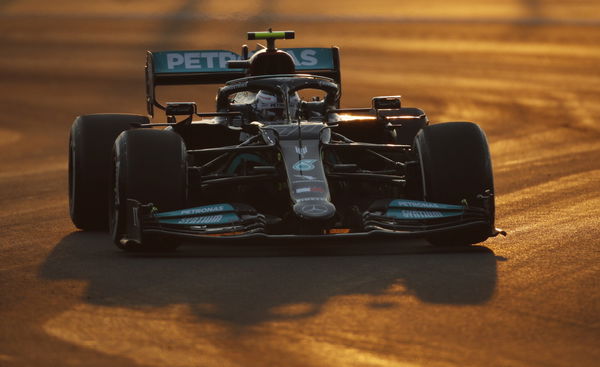
via Reuters
Formula One F1- Saudi Arabian Grand Prix – Jeddah Corniche Circuit, Jeddah, Saudi Arabia – December 4, 2021 Aston Martin’s Sebastian Vettel in action during practice REUTERS/Hamad I Mohammed

via Reuters
Formula One F1- Saudi Arabian Grand Prix – Jeddah Corniche Circuit, Jeddah, Saudi Arabia – December 4, 2021 Aston Martin’s Sebastian Vettel in action during practice REUTERS/Hamad I Mohammed
Formula 1, the pinnacle of motorsport, is certainly one of the most expensive series in the entire world with leading F1 racing outfits like Mercedes, McLaren, and Ferrari spending big bucks to keep themselves competitive enough amongst a grid of elites.
Hence, right until the end of 2020, it has always been the richest team of all winning the championship titles. There were even rumors that Mercedes managed to spend close to half a billion dollars back in 2019, which eventually led to them dominating the entire racing grid and winning what was then their sixth constructors’ championship trophy.
However, then arrived the budget cap in 2021! F1, having witnessed sheer Mercedes dominance over the entire hybrid era, was desperately seeking ways to end this one-sided affair.
ADVERTISEMENT
Article continues below this ad
Cost of running an F1 team
As mentioned earlier, F1 is indeed a very expensive sport and most of the team owners here come from immensely wealthy families. For instance, Aston Martin (formerly known as Racing Point) runs under the governance of Canadian billionaire Lawrence Stroll. He is currently worth over $3.2 billion. Astonishing isn’t it?
But, again, amidst the introduction of budget caps, F1 has gotten a lot cheaper. No bottom-field teams will have to worry about financial constraints. Every single Formula 1 team, right from the wealthiest to the poorest, must spend only within the given budget window.

via Reuters
2018 FORMULA 1 SINGAPORE AIRLINES SINGAPORE GRAND PRIX (13 September 2018) – Zone 1 – Pitlane Experience General View Singapore Grand Prix via Reuters Plus
As of 2021, the budget cap stood at around $145 million, and the numbers are likely to fall further as we head deeper into the new era; In 2022, F1 teams are allowed to spend up to $140 million.
Meanwhile, in other racing series like NASCAR, the team budget is even lower, averaging around $140 million. Running a team in NASCAR can cost at least around $15 million.
Are there budget differences between F1 teams?
Again, until 2020, there was a big difference between the most successful team and the least successful team in terms of yearly spending. In 2020, Mercedes, the constructors’ world champion, spent over $450 million while Haas, the most struggling F1 team, had a budget of around $80 million.

via Reuters
Formula One F1 – Young Driver Test – Yas Marina Circuit, Abu Dhabi, United Arab Emirates – Red Bull’s Max Verstappen and mechanics during testing REUTERS/Hamad I Mohammed
However, from 2021, there isn’t much difference between the teams. According to Guenther Steiner, the difference in budget between the teams has come down from hundreds of millions of dollars to mere tens of millions of dollars. “What I try to focus on is before they had three times the budget, which is an advantage of $2-300 million. Now, even if the big teams have got an advantage, it’s maybe $10-20 million,” he said as quoted by The Race.
Which F1 teams have the biggest budgets?
This is a rather straightforward question, isn’t it? Well, ever since the dawn of the V6 era, three F1 teams have been right at the top of the spending chart – Mercedes, Ferrari, and Red Bull. The big three are financially sound and their big investments have always reflected in their on-track performances.
In 2019, Mercedes spent around $484 million while Ferrari spent $463 million, and finally, Red Bull invested $445 million. Following the top teams, the richest mid-field team is Renault, who recorded annual spending of $272 million in 2020; Quite far from the trio of title-contending teams.

via Reuters
Formula One F1- Saudi Arabian Grand Prix – Jeddah Corniche Circuit, Jeddah, Saudi Arabia – December 4, 2021 General view as the cars exit the pit lane during qualifying Pool via REUTERS/Giuseppe Cacace
Well, despite the arrival of budget caps, it is likely that the top three teams will continue to dominate the grid for the time being. However, in time, there is a significant chance that the rest of the grid will catch up with the leaders.
Watch This Story: From Prince to the Queen: When F1 Stars Interacted With the Royal Family
What are the new budget caps?
A lot have pondered upon this question for quite a while now. Well, the root of F1 making such a move is Mercedes. The Silver Arrows have showcased an immense level of dominance over the rest of the grid, pretty much killing the entertainment factor.
But one can’t really blame the team, can they? Mercedes, in fact, houses the finest set of engineers, and along with big budgets, they’ve managed to cherish an amazing on-track success. Hence, F1 needed to regroup the teams amidst categorizations like top-field, mid-field, and bottom-field.

via Reuters
Formula One F1 – Qatar Grand Prix – Losail International Circuit, Lusail, Qatar – November 19, 2021 Mercedes’ Lewis Hamilton during practice REUTERS/Hamad I Mohammed
The sport wanted the least-competitive teams like Williams and Haas to challenge for the titles. And the only way to accomplish the goal is by obstructing the leading teams from spending a lot of money. This led to the establishment of budget caps.
The entire grid will now have to manage their respective teams within the budget of $145 million, which is almost one-third of Mercedes’ spending in 2020. In 2022, the cost cap was reduced by $5 million to $140 million. 2023 saw further reductions to the budget cap, and a revised budget of $135 million was finalized.
ADVERTISEMENT
Article continues below this ad
Did the budget caps level the playing field?
Not yet! Of course, it isn’t something that is expected to happen right away. The big three teams are still light-years away from the rest of the grid. Hence, it will take time for the mid-field and the bottom-field runners to reach up to the level of the title challengers.

via Reuters
Formula One F1 – Italian Grand Prix – Autodromo Nazionale Monza, Monza, Italy – September 12, 2021 Olympic 100m champion Italy’s Marcell Jacobs waves the checkered flag as McLaren’s Daniel Ricciardo wins the race REUTERS/Jennifer Lorenzini
The 2021 season witnessed a handful of teams, including McLaren and Ferrari, securing pole positions, podiums, and even a race win. And this is indeed a clear sign of the transition that F1 has been yearning for.
ADVERTISEMENT
Article continues below this ad
| F1 Teams | Budget Between 2015 & 2019 | ||||
| 2015 | 2016 | 2017 | 2018 | 2019 | |
| Mercedes | $527.6M | $352M | $352.1M | $400M | $484M |
| Ferrari | $474.7M | $483.3M | $295.3M | $410M | $463M |
| Red Bull | $532.5M | $286.2M | $284M | $310M | $445M |
| McLaren | $528.3M | $246.4M | $240.8M | $220M | $269M |
| Alpine (Renault/Lotus) | $149.8M | 199.8M | $195.4M | $190M | $272M |
| Aston Martin (Racing Point/Force India) | $147.3M | $119.2M | $117M | $120M | $188M |
| AlphaTauri (Toro Rosso) | $156.1M | $132.8M | $130.6M | $150M | $138M |
| Alfa Romeo (Sauber) | $117.2M | $126M | $123.8M | $135M | $132M |
| Williams | $217.7M | $139.6M | $136.3M | $150M | $141M |
| Haas | NA | NA | $130.6M | $130M | $173M |
Read More: How Much Does a Formula One Car Cost?
ADVERTISEMENT
ADVERTISEMENT
ADVERTISEMENT
ADVERTISEMENT

